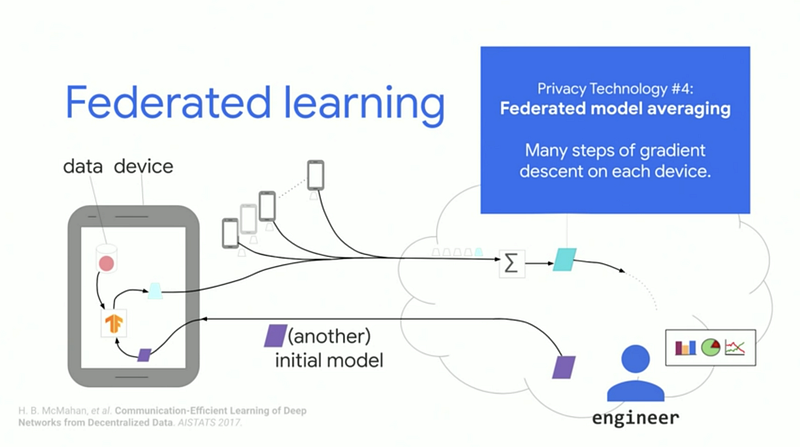The Magical World of Edge AI and Federated Learning: Unleashing the Power of Smart Devices and Protecting Data Privacy

Hello there, tech enthusiasts! Ready to be amazed by the miracles of artificial intelligence like you’ve never seen before? Welcome to Edge AI and Federated Learning, where machines transform into intelligent partners, making instantaneous choices.
In an era characterized by rapid technological advancements, the boundaries between the physical and digital realms are becoming increasingly blurred. This transformative landscape is reshaping our interactions with technology and redefining our data processing and privacy expectations. Two groundbreaking concepts are central to this paradigm shift: Edge AI and Federated Learning. As we stand on the cusp of this technological revolution, it’s imperative to understand these innovations and their profound implications. While Edge AI empowers devices with localized intelligence, enabling faster and more efficient data processing, federated learning facilitates collaborative AI training without compromising individual data privacy. Together, they represent a harmonious blend of innovation and protection, promising a future where smart devices are more capable and inherently respectful of our privacy. As we embark on this exploration, we’ll delve deeper into these transformative technologies, uncovering the magic at the intersection of intelligence and integrity.
Edge AI: Revolutionizing Localized Data Processing
Edge AI is a groundbreaking advancement in artificial intelligence, reshaping our understanding of data processing and device interaction; unlike traditional models that rely on centralized servers for data analysis, Edge AI champions a decentralized approach. Here, the magic unfolds directly on or near the data source, whether a smartphone, IoT device, or edge server. This shift is not merely about location but fundamentally alters how quickly and efficiently devices can operate. With Edge AI, the delay of sending data back and forth to distant servers diminishes, paving the way for real-time decision-making and faster responses. Moreover, this localized processing brings forth a boon in data privacy. By keeping sensitive information closer to home, Edge AI minimizes the inherent risks associated with frequent data transfers to external servers, placing more control in users’ hands. This transformative potential finds resonance across sectors, from smart homes, where devices learn and adapt without cloud intervention, to healthcare, benefiting from instantaneous diagnostics and interventions. In essence, Edge AI represents a future where intelligence is powerful and intimately connected to our daily experiences while preserving the sanctity of our data.
Federated Learning: Collaborative Intelligence with Privacy at Its Core

In the evolving tapestry of artificial intelligence, Federated Learning is a pioneering approach that marries the prowess of collaborative intelligence with an unwavering commitment to data privacy. This section unravels the intricate workings of Federated Learning, shedding light on its transformative potential and its pivotal role in shaping a privacy-centric future.
Federated Learning reimagines the conventional model of AI training, which typically necessitates pooling vast datasets into centralized repositories. Instead, it champions a distributed approach, allowing multiple devices to learn a shared model collaboratively without divulging their raw data. This methodology holds profound implications, not just for technological advancements but also for safeguarding individual privacy.
The beauty of Federated Learning lies in its iterative and collaborative nature. Initially, a global AI model is crafted and dispatched to individual devices. These devices, ranging from smartphones to edge servers, then embark on localized training sessions using their respective datasets. Crucially, rather than transmitting raw data, only the refined model updates — capturing knowledge gleaned during training — are communicated back to a central server. Here, these updates converge, iteratively refining the global model. This cyclical process of local training and global aggregationensures that collective intelligence grows exponentially, all while preserving the sanctity of individual data.
There are numerous advantages to Federated Learning. Foremost is its unparalleled capability to uphold data privacy. Federated Learning mitigates the risks associated with data breaches and unauthorized access by ensuring that raw data remains siloed within individual devices. Furthermore, this collaborative paradigm fosters a more inclusive and diverse training environment. By tapping into myriad datasets from various sources, the resultant AI models are robust, adaptive, and reflective of real-world complexities.
The Dynamic Duo: Edge AI and Federated Learning — An Unstoppable AI Team!

As we venture deeper into the intricacies of modern artificial intelligence, the confluence of Edge AI and Federated Learning emerges as a potent combination, redefining the boundaries of what’s achievable in decentralized, intelligent systems. This section delves into the harmonious synergy between these two transformative technologies, elucidating how their convergence amplifies capabilities while fortifying data privacy.
At their core, Edge AI and Federated Learning challenge the conventional wisdom of centralized data processing. While Edge AI focuses on localized intelligence and processing data directly on individual devices, Federated Learning emphasizes collaborative model training without needing raw data exchange. These technologies create a symbiotic ecosystem where devices process data intelligently and collaboratively refine their collective knowledge when integrated.
The integration begins with Edge AI-enabled devices leveraging their local processing capabilities to execute sophisticated AI algorithms. These devices, equipped with localized intelligence, can perform real-time analytics, make autonomous decisions, and even initiate preliminary model training. As these localized models evolve, they generate insights and updates that are far more prosperous and more contextual than raw data streams.
Herein lies the brilliance of Federated Learning. Instead of transmitting voluminous raw data across networks — a process fraught with privacy risks — Edge AI devices communicate concise model updates to a centralized server. This server, equipped with Federated Learning algorithms, amalgamates these updates, iteratively refining the global AI model. The result is a virtuous cycle of local intelligence driving global insights, all while ensuring that individual data remains confidential and secure.
The synergistic interplay between Edge AI and Federated Learning unlocks many opportunities across diverse domains.
Here’s a detailed exploration of the real-world use cases of Edge AI and Federated Learning in various sectors.

Healthcare — Remote Monitoring and Diagnostics: The fusion of Edge AI and Federated Learning in healthcare revolutionizes patient care and diagnostics. Devices such as wearable ECG monitors and blood glucose sensors are now equipped with Edge AI algorithms that analyze real-time data, enabling timely interventions by alerting medical professionals about potential health anomalies. This real-time analysis enhances patient safety and minimizes the need for frequent hospital visits, optimizing healthcare resources. Concurrently, Federated Learning facilitates collaborative research and development across hospitals and research institutions. For instance, AI models can be trained collaboratively to predict disease outbreaks or monitor the efficacy of treatment protocols across diverse patient populations. This collaborative approach ensures that healthcare insights are enriched by a broad spectrum of data sources while meticulously preserving patient privacy and adhering to regulatory standards.
Smart Agriculture – Precision Farming: The agricultural sector is witnessing a paradigm shift with the integration of Edge AI and Federated Learning. Agricultural drones, empowered by Edge AI algorithms, now analyze crop health, soil conditions, and pest activity in real time. This granular analysis allows farmers to make informed, data-driven decisions about irrigation, fertilization, and pest control, ultimately enhancing crop yields and sustainability. In parallel, Federated Learning enables agricultural cooperatives from different regions to train AI models collaboratively. These models can predict weather patterns, optimize supply chains, and manage agricultural resources more efficiently. By harnessing collective insights from diverse agricultural landscapes, Federated Learning ensures that precision farming practices are tailored to local conditions while preserving the integrity and privacy of individual farming data.
Autonomous Vehicles – Safe and Efficient Transportation: The automotive industry stands on the brink of a technological revolution driven by the synergy of Edge AI and Federated Learning in autonomous vehicles. Self-driving cars with Edge AI capabilities can process sensor data and make split-second decisions, such as lane changes and obstacle avoidance, ensuring safe and efficient navigation in dynamic environments. This localized processing reduces latency and enhances the vehicle’s responsiveness, critical factors for ensuring passenger safety. Moreover, Federated Learning facilitates continuous improvement in autonomous driving capabilities. Automotive manufacturers can collaboratively refine AI models by aggregating insights from vehicles worldwide, enhancing safety measures, optimizing vehicle performance, and accelerating the adoption of autonomous technologies globally.
Retail – Personalized Customer Experiences: The retail landscape is transforming, with Edge AI and Federated Learning reshaping customer experiences and operational efficiency. In-store cameras and sensors, powered by Edge AI, now analyze customer behavior and preferences in real time, enabling retailers to offer personalized product recommendations and optimize store layouts. This hyper-personalization fosters customer loyalty and drives sales, creating a win-win scenario for retailers and consumers. Concurrently, Federated Learning empowers retail chains to collaboratively train AI models for demand forecasting, inventory management, and customer segmentation. By leveraging collective insights from diverse markets and customer demographics, Federated Learning ensures that retail strategies are data-driven, adaptable, and aligned with evolving consumer preferences, all while preserving regional data privacy and compliance with regulatory frameworks.
Finance – Enhanced Security and Decision-making: The financial sector is harnessing the transformative potential of Edge AI and Federated Learning to redefine security protocols, customer interactions, and decision-making processes. Banking applications, fortified by Edge AI algorithms, now detect fraudulent transactions in real time, provide personalized financial advice, and automate customer support services. This seamless integration enhances user experience, mitigates risks, and fosters trust in digital banking solutions. Concurrently, Federated Learning is revolutionizing financial analytics and risk management practices. Financial institutions can collaboratively refine AI models for credit scoring, risk assessment, and investment strategies by aggregating insights from diverse market conditions and customer demographics. This collaborative approach ensures that financial decisions are data-driven, robust, and aligned with regulatory standards while safeguarding sensitive financial information and preserving client confidentiality.
Challenges and Considerations
As Edge AI and Federated Learning continue gaining traction across various industries, it’s crucial to recognize the inherent challenges and considerations accompanying these transformative technologies. While they offer immense potential, a nuanced understanding of their limitations and implications is essential for responsible and effective deployment.
Data Privacy and Security Concerns: One of the foremost challenges is navigating the intricate landscape of data privacy and security. Edge AI processes data locally, which can mitigate certain privacy risks. However, ensuring robust encryption, secure data storage, and adherence to data protection regulations remains paramount. Similarly, Federated Learning aims to preserve data privacy by training models without centralized data pooling. Yet, ensuring the confidentiality of model updates and implementing stringent access controls are critical to prevent unauthorized data exposure or breaches.
Computational Limitations and Resource Constraints: Edge devices like IoT sensors or smartphones often have limited computational capabilities and resources. Balancing the computational demands of AI algorithms with the constraints of edge devices requires innovative solutions, such as optimizing algorithms for efficiency, leveraging edge-cloud collaboration, or employing edge-specific hardware accelerators. Similarly, Federated Learning necessitates robust synchronization mechanisms and efficient communication protocols to facilitate collaborative model training across diverse devices without overwhelming network bandwidth or computational resources.
Model Robustness and Bias Mitigation: Ensuring the robustness and fairness of AI models remains a significant consideration. Edge AI models trained on limited or biased datasets may exhibit suboptimal performance or inadvertently perpetuate existing biases. Rigorous data preprocessing, diverse dataset curation and ongoing model evaluation are essential to mitigate biases and enhance model fairness. In the context of Federated Learning, federated aggregation techniques and collaborative model evaluation can help address biases across distributed datasets and foster more inclusive AI models.
Regulatory Compliance and Ethical Considerations: Navigating the evolving regulatory landscape and ethical implications of AI deployment is a multifaceted challenge. Compliance with data protection regulations, industry-specific standards, and ethical guidelines requires proactive governance, transparent practices, and stakeholder engagement. Moreover, addressing potential ethical dilemmas, such as algorithmic transparency, consent management, and equitable access to AI-driven services, fosters trust, promotes responsible AI usage, and mitigates unintended consequences.
Integration and Interoperability: The seamless integration of Edge AI and Federated Learning with existing systems, platforms, and workflows presents another set of challenges. Ensuring compatibility, interoperability, and scalability across heterogeneous environments requires collaborative efforts, standardized interfaces, and modular architectures. Addressing the diverse requirements and constraints of different industries, applications, and stakeholders necessitates flexible solutions, adaptive frameworks, and continuous collaboration between technology providers, domain experts, and regulatory bodies.
Future Implications and Predictions
As Edge AI and Federated Learning continue to evolve and permeate various sectors, their future implications and potential trajectories offer a fascinating glimpse into the next frontier of technological innovation. The convergence of these technologies is poised to reshape industries, redefine user experiences, and catalyze a paradigm shift in how we perceive and harness the power of artificial intelligence.
Decentralized Intelligence and Ubiquitous Computing: The proliferation of Edge AI is set to usher in an era of decentralized intelligence and ubiquitous computing. As edge devices become more sophisticated and interconnected, we can anticipate a proliferation of intelligent ecosystems where devices collaboratively process data, make autonomous decisions, and adapt to dynamic environments in real time. This decentralized paradigm will enhance efficiency and responsiveness. It will also foster resilience, scalability, and adaptability across diverse applications, from smart cities and autonomous vehicles to industrial automation and personalized healthcare.
Collaborative Intelligence and Global Knowledge Sharing: Federated Learning is poised to catalyze a revolution in collaborative intelligence and global knowledge sharing. As organizations recognize the value of collective insights and joint model training, we expect more federated ecosystems where AI models are continuously refined, enriched, and democratized across diverse stakeholders, domains, and geographies. This collaborative ethos will fuel innovation, accelerate knowledge dissemination, and foster a culture of shared learning, collaboration, and collective advancement in the global AI community.
Ethical AI and Responsible Innovation: The convergence of Edge AI and Federated Learning will necessitate a renewed focus on ethical AI and responsible innovation. As AI systems become more pervasive and autonomous, addressing ethical dilemmas, ensuring algorithmic transparency, and fostering equitable access to AI-driven services will become imperative. We anticipate a paradigm shift towards ethical AI frameworks, transparent governance models, and inclusive AI solutions prioritizing fairness, accountability, and societal well-being, fostering trust, promoting responsible AI adoption, and mitigating unintended consequences in an increasingly interconnected and AI-driven world.
Personalized Experiences and Adaptive Intelligence: Integrating Edge AI and Federated Learning will pave the way for hyper-personalized experiences and adaptive intelligence. As AI systems become more context-aware and user-centric, we expect a proliferation of personalized services, tailored recommendations, and adaptive interfaces that anticipate user needs, preferences, and behaviors in real-time. This personalized paradigm will enhance user satisfaction and engagement, foster a deeper understanding of individual preferences, facilitate intuitive interactions, and catalyze innovation in user experience design, content delivery, and digital transformation across diverse industries and applications.
Resilient Infrastructures and Robust Systems: The synergy between Edge AI and Federated Learning will drive advancements in resilient infrastructures and robust systems. As organizations prioritize reliability, security, and scalability, we can anticipate a shift towards decentralized architectures, edge-cloud integration, and federated ecosystems. This will mitigate risks, enhance system performance, and optimize resource utilization. It will also foster innovation, promote agility, and catalyze system design, architecture, and optimization advancements across diverse domains and applications.
Conclusion
The transformative journey of Edge AI and Federated Learning has illuminated a path toward a future where decentralized intelligence, collaborative innovation, and personalized experiences converge to redefine the boundaries of technological possibility. As we navigate the complexities and challenges of this evolving landscape, it becomes evident that the synergy between Edge AI and Federated Learning holds the key to unlocking unprecedented opportunities for innovation, efficiency, and responsible AI adoption across diverse sectors and applications.
The convergence of Edge AI and Federated Learning heralds a new era of decentralized intelligence, collaborative innovation, and personalized experiences, offering a glimpse into a future where technology catalyzes positive change, societal well-being, and collective advancement in an increasingly interconnected and AI-driven world.
References:
- Bonawitz, K., et al. (2019). Towards Federated Learning at Scale: System Design. arXiv preprint arXiv:1902.01046.
- Satyanarayanan, M. (2017). The Emergence of Edge Computing. Computer Magazine, 50(1), 30–39.
- Kairouz, P., et al. (2019). Advances and Open Problems in Federated Learning. arXiv preprint arXiv:1912.04977.
- Sandler, M., et al. (2019). MobileNetV2: Inverted Residuals and Linear Bottlenecks. Proceedings of the IEEE Conference on Computer Vision and Pattern Recognition


